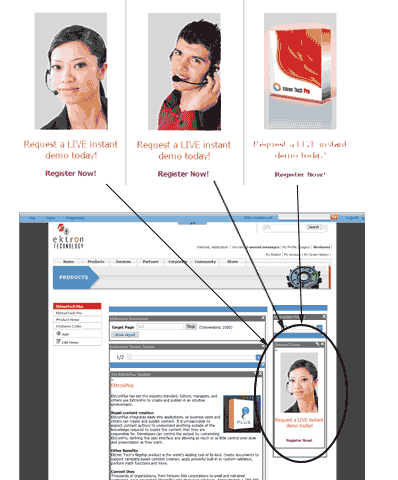
Chapter 11 - Optimizing Page Layout with Multivariate Testing
Multivariate testing allows you to offer several variations of the same page, then measure site visitors' reactions to each variation. The one that generates the most conversions is automatically promoted to the design for that page, thereby maximizing your Web site's ROI.
The variations can alter any number of page elements (images, copy, buttons, form fields, etc.) to find the combination that most effectively compels site visitors to take the next step. No longer do you need to speculate on the best page design -- now, you can use actual, timely data drive those decisions.
Ektron CMS400.NET Multivariate testing is easy to implement, requiring no help from a developer or designer.
How Multivariate Testing Works
Content variations appear to site visitors during an experiment. The page variation that a site visitor sees is randomly selected by the system. When a visitor navigates to a special page called the target, it is logged as a conversion. A conversion might be a donation, registration, sales lead, etc. Conversions are tracked, and the variation that produces the most conversions is automatically promoted to the Web site.
Sometimes, this type of testing is called “A/B Testing”, but Multivariate Testing is far more than that. A/B testing provides only a few variations. With Multivariate Testing, the number of page combinations grows exponentially as the number of layout and content combinations increase.
Important: The Multivariate Testing feature requires the use of PageBuilder templates. For more information, see Building Pages.
Also, the Multivariate testing feature is part of Ektron's Marketing Optimization Suite. For more information about the suite, including webinars, white papers, instant demonstrations, etc., see http://ektron.com/marketingoptimization/.
An Example of Multivariate Testing
In the example below, the marketing manager wants to know which of three ads produces the most visits to a registration page.

The experiment page contains ads that link to a registration form.
A target page contains the registration form.
A conversion is a visits to the target page produced by each ad.
When the target number of conversions occurs, the variation achieving it automatically becomes the permanent page on the site. The optimum page runs on the web site without further effort by the Web site Admin.
This section also contains the following topics.
Using Widgets for Multivariate Testing
Using PageBuilder Pages and Content
Creating a Multivariate Experiment


